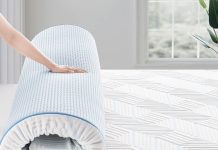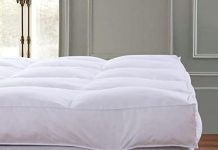In the world of bedding and textiles, there’s a term that often comes up: thread count. You may have heard it before, you may even have a general idea of what it means, but do you really understand its significance? In this article, we’re going to delve into the world of thread count and explore its relationship with fabric quality. By the end, you’ll have a clear understanding of why thread count is more than just a number. So, let’s dive in and uncover the truth behind thread count and fabric quality.
Review contents
What is Thread Count?
Definition of thread count
Thread count refers to the number of threads in a square inch of fabric. It is determined by counting the number of horizontal and vertical threads in a one-inch square and adding them together. The resulting number represents the thread count, with higher numbers indicating a higher density of threads.
How thread count is calculated
To calculate the thread count, manufacturers count the number of horizontal (weft) and vertical (warp) threads within a one-inch area of fabric. These threads are then added together to determine the thread count. For example, if a fabric has 200 horizontal threads and 200 vertical threads per square inch, the thread count would be 400.
Importance of thread count in fabric quality
Thread count is often associated with fabric quality because a higher thread count generally indicates a finer, smoother fabric. Fabrics with a higher thread count usually have a tighter weave, resulting in a softer and more luxurious feel. However, while thread count does play a role in fabric quality, it is not the sole factor to consider.
Factors Affecting Thread Count
Types of fibers used
The type of fibers used in the fabric can affect the thread count. Natural fibers like cotton, linen, and silk tend to have a lower thread count because their thicker fibers require more space. Synthetic fibers like polyester and microfiber, on the other hand, can have a higher thread count due to the fineness of the individual threads.
Weaving techniques
Different weaving techniques also impact the thread count. Basic weaves, such as plain weave, often have a lower thread count, while more intricate weaves like satin or sateen can result in a higher thread count. These weaving techniques affect the density and arrangement of the threads, influencing the overall thread count and fabric quality.
Ply of the threads
Ply refers to the number of yarns twisted together to create a single thread. Single-ply fabrics have a lower thread count compared to multi-ply fabrics. While multi-ply threads can contribute to a higher thread count, the actual quality of the fabric is determined by other factors, such as the type of fiber and weaving technique.
Number of threads per inch
Apart from the horizontal and vertical thread count used to calculate the overall thread count, the number of threads per inch can also affect the fabric quality. Higher thread density means smaller gaps between threads, resulting in a smoother and more durable fabric. However, it is worth noting that a higher thread count does not always guarantee better fabric quality, as other factors come into play.
Understanding Fabric Quality
Definition of fabric quality
Fabric quality refers to the overall characteristics and attributes of a fabric that determine its performance, durability, and comfort. It encompasses various factors, including the raw materials used, manufacturing techniques, and finishing processes. Fabric quality directly impacts its suitability for different purposes and its ability to retain its appearance and functionality over time.
Factors determining fabric quality
While thread count is often associated with fabric quality, it is just one aspect to consider. Other factors that help gauge fabric quality include the type of fibers used, the weave structure, the weight of the fabric, and the finishing treatments applied. The combination of these factors determines the fabric’s strength, breathability, texture, and overall performance.
Impact of fabric quality on comfort and durability
Fabric quality plays a significant role in both comfort and durability. High-quality fabrics generally offer better breathability, moisture-wicking properties, and a softer feel against the skin. They are also more likely to withstand rigorous use, frequent washing, and maintain their color and texture over time. Investing in fabrics of superior quality ensures long-lasting comfort and durability.
Thread Count vs. Fabric Quality
Thread count as an indicator of fabric quality
While thread count is often associated with fabric quality, it is important to recognize that it is not the sole determinant. Higher thread count fabrics typically have a smoother and softer feel, which can be perceived as a mark of quality. However, fabric quality encompasses several other factors, such as the type of fibers used and the weaving techniques employed.
Limitations of relying solely on thread count
Relying solely on thread count as a measure of fabric quality can be misleading. Some manufacturers artificially increase thread count by using thinner, lower-quality threads or double-counting plied threads. This can result in a fabric with a high thread count but inferior quality. Therefore, it is essential to consider multiple factors beyond just thread count when evaluating fabric quality.
Other qualities to consider for fabric quality
While thread count is a useful indicator, it is vital to consider other qualities when assessing fabric quality. These include the type and origin of the fibers, the construction and finish of the fabric, and any certifications for sustainability or performance. Evaluating fabric quality holistically ensures a more accurate understanding of its overall performance and suitability for specific needs.
Effects on Comfort
Thread count’s influence on comfort
Thread count can impact comfort by determining the level of softness and smoothness of the fabric. Higher thread count fabrics tend to have a finer texture, resulting in a more comfortable feel against the skin. The tightly-woven threads also contribute to better breathability, allowing air to circulate and regulating body temperature for a more comfortable sleep or wear.
Other fabric factors affecting comfort
While thread count plays a role, fabric comfort is influenced by several other factors. The type of fibers used can affect moisture-wicking properties and breathability. Weave structure, such as sateen or percale, can impact texture and feel. Additionally, fabric weight, flexibility, and hypoallergenic features contribute to overall comfort levels. Considering these factors alongside thread count ensures optimal comfort.
Finding the right balance
The ideal thread count for comfort can vary depending on individual preferences and specific needs. While higher thread count fabrics are generally associated with comfort, they may not be suitable for everyone. Some individuals prefer a slightly lower thread count for a crisper feel or increased breathability. Personal preference, season, and climate should all be considered when choosing the right fabric for ultimate comfort.
Durability and Longevity
Thread count’s impact on fabric durability
Thread count can affect fabric durability to some extent. Higher thread count fabrics often have a tighter weave, which can result in increased strength and durability. The densely-woven threads are less prone to tearing, fraying, or developing holes. However, thread count alone does not dictate the fabric’s overall durability, as other factors like fiber quality and weave structure also play significant roles.
Additional factors determining fabric longevity
While thread count contributes to fabric longevity, other factors are equally important. The quality and type of fiber used significantly influence the fabric’s ability to withstand regular use, washing, and exposure to external elements. Additionally, factors like dye stability, colorfastness, and resistance to pilling or fading are crucial in maintaining a fabric’s appearance and lifespan.
Choosing fabrics for specific purposes
Different fabric qualities are required for various purposes. For high-wear items like bed sheets or upholstery, fabrics with a higher thread count may provide better durability. However, for lightweight garments or warmer climates, a lower thread count fabric may offer more breathability and flexibility. Considering the intended use and specific requirements helps in selecting fabrics that will exhibit optimal longevity.
Price and Value
The correlation between thread count and price
In the market, thread count often affects the price of a fabric. Fabrics with higher thread counts are generally associated with higher costs. This is due to the perception of increased quality and luxuriousness, as well as the higher production costs associated with achieving a denser weave. However, it is important to note that thread count alone does not dictate a fabric’s value.
Determining value beyond thread count
To determine the true value of a fabric, it is vital to consider multiple factors beyond thread count. The type of fibers used, the overall fabric quality, and its performance attributes contribute to its value proposition. A fabric with a lower thread count but superior fiber quality and construction may offer better value in terms of comfort, durability, and long-term satisfaction.
Best options for different budgets
There are fabric options available for every budget, regardless of thread count. Higher thread count fabrics may be more expensive, but they may not necessarily be the best choice for everyone. Understanding personal preferences, desired fabric qualities, and exploring a range of options can help find fabrics that provide the best value within a specific budget.
Choosing the Right Fabric
Identify your priorities
Before choosing a fabric, it is important to identify individual priorities. Consider factors such as comfort, durability, breathability, ease of care, and any specific requirements for the intended purpose. This will help determine the ideal combination of qualities and guide the decision-making process.
Understanding fabric labels
Fabric labels provide essential information about the fabric’s composition, thread count, and care instructions. Learning to interpret fabric labels enables consumers to make more informed choices. Look for labels that indicate the fiber content, weave structure, and any additional certifications or performance attributes the fabric may possess.
Sourcing trustworthy brands and manufacturers
To ensure fabric quality and authenticity, it is advisable to source fabrics from trustworthy brands and manufacturers. Research reputable companies known for their commitment to producing high-quality fabrics. Read customer reviews, seek recommendations, and consider their reputation for transparency, sustainability, and ethical manufacturing practices.
Seeking professional advice
When in doubt, seeking professional advice from interior designers, fabric experts, or experienced sales professionals can be valuable. They can provide guidance based on their knowledge and experience, helping identify fabrics that align with specific requirements and preferences.
Caring for High-Quality Fabrics
Proper washing and drying techniques
High-quality fabrics require proper care to maintain their appearance and durability. Follow the manufacturer’s care instructions for washing and drying, paying attention to water temperature, laundry detergents, and any special considerations. Avoid high heat settings and harsh chemicals that can potentially damage the fabric.
Special care instructions for delicate fabrics
Delicate fabrics may require extra care and attention. Some fabrics need to be hand-washed or dry cleaned to ensure their longevity. It is crucial to be aware of any special care instructions provided by the fabric manufacturer or consult professionals for the best practices to preserve delicate fabrics.
How to maintain fabric quality over time
To maintain fabric quality over time, it is essential to handle fabrics with care. Avoid rough handling, excessive stretching, or exposure to direct sunlight for extended periods. Regularly rotate cushions and pillowcases to distribute wear evenly. Taking preventive measures, such as using fabric protectors and avoiding harsh chemicals or direct heat, can help extend the life of high-quality fabrics.
Conclusion
Considering both thread count and fabric quality together is crucial in making informed decisions when selecting fabrics. While thread count plays a role in fabric quality, it is not the sole indicator. Factors such as fiber type, weaving techniques, and overall fabric construction also impact quality. By finding the right balance for individual preferences and priorities, consumers can choose fabrics that offer optimal comfort, durability, and value for their specific needs. With proper care and maintenance, high-quality fabrics can provide long-lasting enjoyment and satisfaction.
























